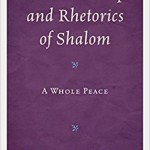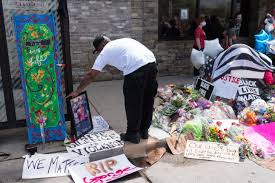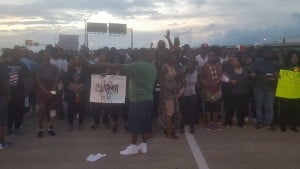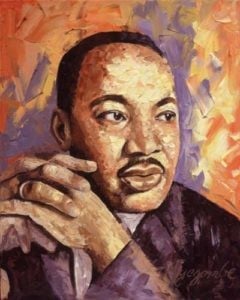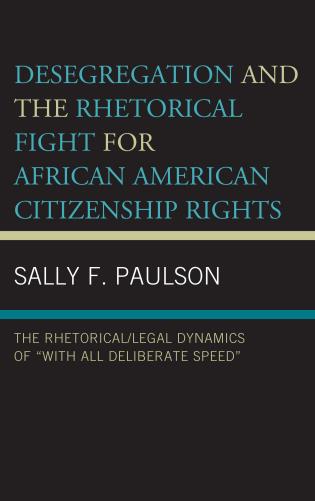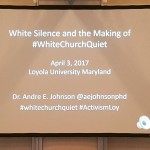 On Monday Night April 3, 2017, the Center for Community Service and Justice at Loyola University-Maryland, invited me to give the Messina Lecture. I talked about white silence and the creation of #WhiteChurchQuiet. I like to thank Dr. Jean Lee Cole for offering the invitation to speak and everyone associated with the wonderful Loyola University-Maryland for their gracious hospitality.
On Monday Night April 3, 2017, the Center for Community Service and Justice at Loyola University-Maryland, invited me to give the Messina Lecture. I talked about white silence and the creation of #WhiteChurchQuiet. I like to thank Dr. Jean Lee Cole for offering the invitation to speak and everyone associated with the wonderful Loyola University-Maryland for their gracious hospitality.
It is indeed an honor and privilege to be with you tonight. Before I start, allow me to give some shout outs if I can. First to Rev. Dr. Heber Brown and the good folk over at Pleasant Hope Baptist Church for inviting and welcoming me and at least fooling me enough to believe I preached well Sunday morning….To Pastor (Amy) McCullough and the good folks at Grace United Methodist Church for inviting me for a stimulating discussion and warm hospitality. To Laura Menyuk the good folks over at Jews United for Justice and participation at the Social Justice Seder—what a powerful time, with those powerful readings. I will always remember this and promise to hold something similar at our church.
To my new scholar friends, I had dinner with on last night along with my new friend Melanie and my good friend Jayme Wooten of Kinetics Live. If you are not following Kinetics Live, you should. Follow him on twitter @KineticsLive, you will be glad you did.
Shout out to Dr. Kaye Whitehead for allowing me an opportunity to talk to her class and hash out some of the ideas I will share tonight. I am grateful for the lunch I had with Drs. Whitehead and Dr. Martin Camper and the students that joined us. Again, we had some rich conversation about movements and what can be done to improve them that I will cherish. And I am thankful to the entire Loyola family for making me feel at home.
However, there is one big shout out left—it is for the person responsible for getting me here, the one who organized the entire trip and the one responsible for getting me out to meet so many people and the one who is not only a top notch scholar in her field but by driving me around, she is also one heck of a chauffer—give it up for the amazing Dr. Jean Lee Cole!!
“I have been so greatly disappointed with the white church and its leadership…….I say this as a minister of the gospel, who loves the church; who has been sustained by its spiritual blessings and who will remain true to it as long as the cord of life shall lengthen.
I felt we would be supported by the white church. I felt that the white ministers, priests and rabbis…..would be among our strongest allies. Instead, some have been outright opponents, refusing to understand the freedom movement and misrepresenting its leaders; all too many others have been more cautious than courageous and have remained silent behind the anesthetizing security of stained-glass windows.
In spite of my shattered dreams, I…..hope(d) that the white religious leadership….would see the justice of our cause and, with deep moral concern, would serve as the channel through which our just grievances could reach the power structure. I had hoped that they would….. understand. But again I have been disappointed.
In the midst of blatant injustices inflicted upon Black bodies, I have watched white religious leaders stand on the sideline and mouth or write pious irrelevancies and sanctimonious trivialities. In the midst of a mighty struggle to rid our nation of racial and economic injustice, I have heard many ministers say: “Those are social issues, with which the gospel has no real concern.” And I have watched many churches commit themselves to a completely otherworldly religion which makes a strange, un-Biblical distinction between body and soul, between the sacred and the secular.
I have traveled all over and on sweltering summer days and crisp autumn mornings I have looked at the beautiful churches with their lofty spires pointing heavenward. I have beheld the impressive outlines of massive religious-education buildings. Over and over I have found myself asking: “What kind of people worship there? Who is their God? Where were their voices of support when bruised and weary black women and men decided to rise from the dark dungeons of complacency to the bright hills of creative protest?”
Now if what I just said sounded familiar, it should—because they were not my words. I did something I like to do in class from time to time. These are the words of Dr. Martin Luther King Jr. in his “Letter from a Birmingham Jail.” I don’t want anybody blaming Dr. Cole for bringing me here and saying on tomorrow, “She brought him here and all he did was recite King’s letter from a Birmingham Jail. I don’t want to be accused of plagiarism. But I do that to prove a point. Sadly, I could recite King’s Letter, taking out identifying marks—such as locations, the word “Negro”, certain contemporary makings from the letter, replace them with current verbiage and situations, and as we say in the Black church, “that thing could preach right now!”
And since on tomorrow we commemorate the 49th anniversary of the death of Martin Luther King Jr, I thought the letter would help frame our discussion on tonight, because my hashtag #WhiteChurchQuiet is nothing new. King too was frustrated with the white church and if Twitter was around then, he too would have #WhiteChurchQuiet—but he did it in a letter. King was disappointed in white religious leaders for their inaction and remaining quiet during the time when black bodies were routinely humiliated, beaten, and/or killed. They were quiet and were not able to see the justice of their cause. King would later say, they even “commended the police” for “keeping order” and “preventing violence” and for King, this was surprising and disappointing.
When I took to Twitter to share my frustrations, I too was disappointed, but not surprised. After hearing the news that law enforcement officials had shot and killed two more black men—Terence Crutcher—the one killed in Tulsa, Oklahoma. BTW, Betty Shelby, who shot and killed Terence Crutcher gave an interview on 60 minutes last night telling us why she shot him, and Keith Scott—the one shot and killed in Charlotte, North Carolina. It’s sad, but when describing some of these high profile shootings, you must associate the name with the city so as not to get confused over which dead black body you are talking about at the time.
So when I heard dead black bodies on the pavement again at the hands of people who are supposed to protect and defend, I was disappointed, but not surprised—and I braced myself for the criticism. While many, rightfully so, took to the streets and protested yet two more state sponsored black deaths gone viral on social media, invariably from some of the protesters and others within the black community, there was the refrain, “Where is the Church?” Really, what people meant when they asked this was “where was the Black Church?”
I know this refrain because even though I serve as a pastor in a black church and celebrate much of the black church tradition, I too have asked the question. For instance, while some rightfully claim that Black Lives Matter did not start as a black church movement therefore, the church should not take part in this movement, many others, and I have consistently asked why not? Why should the black church continue to sit on the sidelines when there is a movement of liberation happening right outside many of our churches? Why should the black church, whose membership is made up of so many people who are targets of over saturated policing, continue to remain silent about this and other problems? Therefore, I do get it—the black church has been missing in action on a host of issues and concerns germane to the African American Community.
However, if there was to be a response from Christians or any church about the injustices that happen on streets across America, it will typically come from the Black Church. At its best, the Black Church has been the home of the African American Prophetic Tradition. I have written about this tradition before. It is a tradition that was birthed from slavery and shaped in Jim and Jane Crow America. It has been the primary vehicle that has comforted and given voice to many African Americans. Through struggle and sacrifice, at its best, this tradition has expressed black people’s call for unity and cooperation, as well as the community’s anger and frustrations. It has been both hopeful and pessimistic. It has celebrated the beauty and myth of American exceptionalism and its special place in the world, while at the same time damning it to Hell for not living up to the promises and ideals America espouses. It is a tradition that celebrates both the Creator or the Divine’s hand in history—offering “hallelujahs” for deliverance from slavery and Jim and Jane Crow, while at the same time asking, “Where in the hell is God?” during tough and trying times. It is a tradition that develops a theological outlook quite different at times from orthodoxy—one that finds God very close, but so far away.
Therefore, when I saw African American pastors and ministers marching with protestors or giving interviews and speaking out, yet again, on abusive police tactics, this time, I asked a different question; “Where was the white church in all of this? I began to wonder do they have anything to say about these killings. I wondered what they were preaching and teaching in their churches. I mean what would it look like for a group of white clergy to come to a bank of microphones and declare Black Lives Matter and for those same clergy to request a meeting with the police director and the DA?
My thinking about the white church response was shaped by a poll I read about research on white churches and race. According to the recent Public Religion Research Institute survey, white Christians simply are far less likely to believe the experiences of Black Americans. For example, on the subject of police killings, while over 80% of Black Christians believe that police killings are part of a much larger problem on how African Americans are policed, 70% of white Christian believe the opposite. It is hard to solve a problem when one believes that you do not have a problem.
To find the answers that I was in search for, I took to Twitter and started the #WhiteChurchQuiet hashtag. I started it because I wanted to hear from members of predominate white churches and get their reasoning behind the silence. I wanted to know what pastors and preachers were saying when yet another black person is shot and killed. I wanted to know how many, who already celebrate law enforcement on a regular basis, would also stand with the victims of police brutality. I wanted to know if they mentioned Black Lives Matter in white churches and if so how was it mentioned.
To my pleasant surprise, many participated in the chat. Many white Christians who participated in the chat shared their frustration of their church’s silence on race. For instance, one twitter follower noted how in her church there was no mentioned about Black Lives Matter but she did receive an email advertisement about an upcoming conceal and carry class. Second, there were those that just joined in to “listen and learn.” Others took to Twitter to share what they had been doing to speak out against racism. However, the overwhelming responses from people who attend white churches were that many white churches leaders are simply afraid to speak out. They fear isolation and many are concerned about their positions and future positions in the church. This however implies that they do know what they do but they simply decide to remain quiet because it’s the much easier route to take.
If this is true, it also says something else—why is it always hard, no matter who you are, to stand up for black lives? Why is it always “courageous” to stand with black people? Why is there risk involved in speaking out against injustices happening disproportionally against black people? Why is it that even if you offer a mild response—just asking people to listen to what black people are saying, you run the risk of offending others?
First, this is why we have a Black Lives Matter movement in the country in the first place. The truth is that black people have been trying to tell others about their plight for years. Black people and indeed, all people of color have tried to share instances of racism in their own lives; in the lives of their children, they have tried to tell anyone who would listen about the injustices they faced on a daily basis. The problem has been that when black people talked, they simply are not believed. Black people have been too sensitive; too loud; too angry; too militant. We have been charged with playing the race card; or the proverbial, “Why do you have to bring race in it? Many times however, we just shut down and wonder sometimes “are we crazy for feeling like this?”
The second reason why this is important is because if this is how the majority of the nation feels about black people and especially (since we are in church), this is how the overwhelming majority of believers feel about black people, then it will be hard to work on finding any solutions in order to move forward. In other words, if you already come to the table, suspect of the truth I may share; if there is already doubt in my narrative, then nothing will get accomplished.
This is why I applaud the efforts of Loyola University Maryland for having programs such as these these that open up space to talk about this issue in an open and honest way. However, this is only a start. We know next, that the hard work of coming to the table in smaller groups to discuss these issues is the next step. This is hard work because when we come to the table to discuss racial issues, typically two feelings come also to the table. For white people, white fragility becomes an issue. Robin DiAngelo defines it “as a state, in which even a minimum amount of racial stress becomes intolerable, triggering a range of defensive moves. These moves include the outward display of emotions such as anger, fear, and guilt, and behaviors such as argumentation, silence, and leaving the stress-inducing situation. These behaviors, in turn, function to reinstate white racial equilibrium. Racial stress results from an interruption,” she argues, “to what is racially familiar.”
So when I say “Black Lives Matter,” someone feels the need to say All Lives Matter—not realizing that if All Lives did in fact matter, I would not have to say Black Lives Matter. Or just acknowledging the possibility that if I do say Black Lives Matter that I am not saying All Lives do not matter. The very fact that many whites assume this is very telling in and of itself.
Or when the discussion is about police accountability and what we can do to have better relations with police departments, someone feels the need to bring up the proverbial, “black on black crime” Usually, it goes something like this. “I wish they would protest all the black on black crime that happens. How come they are not marching about this? There are three problems with that push back though. First, sadly, crime is about proximity—it’s relational. People commit crimes against people they are around the most. By this metric, we should talk about white on white crime since according to the FBI stats; 86% of crime committed against white people is by whites.
Second, protests are about perceived injustices and the system not working as it should. Typically, when crime happens in a certain area and with certain people, the system we have in place adjudicates the matter. When perceived crimes happen, when certain others are involved and the system does not work, as it should, then protests happen.
But finally, I understand why well-meaning people would bring it up. I just then ask, well, tell me what you are doing to address it; maybe I can help? This is usually when I get blank stares and the reality sets in—that one usually brings this up to move away from an issue one may not feel comfortable in discussing.
However, it not only white fragility that comes to the table when we talk about race, but for many people of color, the politics of respectability is an issue. Coined by Evelyn Brooks Higginbotham, politics of respectability “refers to attempts by marginalized groups to police their own members and show their social values as being continuous, and compatible, with mainstream values rather than challenging the mainstream for its failure to accept difference.” In other words, many times black people, hijacked by respectability issues, when they come to the table to talk about race, try to show that they are somehow the same as everyone else, and not like those other folks. Respectability’s aim is to allow white people to be as comfortable as possible; not to give rise to white fragility.
This is why Black Lives Matter is problematic sometimes for both blacks and whites. It’s not at all concerned with white fragility or respectability politics. It is not at all concern with the “appropriate attire or behavior.” It is not at all concerned with the right way to speak or the right things to say. Its not concerned with the right way to protest because they know history and there is never a “right way to protest” for those in power. It is not at all concerned with any of that. It is concerned with speaking the truth—black truth, as they see it and feel it and bearing witness.
And maybe that’s another problem we have—hearing and accepting Black Truth because truth be told, Black truth and testimony has always been questioned and viewed as inaccurate. It’s almost as if truth and Blackness can not coincide together–that Black truth was somehow tainted because of the conditions Black folks found themselves. For a long period in this country, black testimony could not be given in courts and black people could not testify in any case against a white person. This of course led to the banning of black people from juries and from courtrooms, unless of course, they were in the role of defendants.
So, first for the white church, I ask, Do you believe black truth? As we discussed yesterday at Grace United Methodist Church, how many times do you have to hear the same stories over and over again before they began to resonate as truth?
For instance, “according to an African American teenager, he was stopped in January 2016 while walking on a street near his home by two officers who were looking for the teenager’s older brother, whom the officers suspected of dealing narcotics. One of the officers pushed the teenager up against a wall and frisked him. This search did not yield contraband. The officer then stripped off the teenager’s jacket and sweatshirt and frisked him again in front of his teenage girlfriend. When this search likewise found no contraband, the officer ordered the teenager to “give your girl your phone, I’m checking you right now.” The officer then pulled down the teenager’s pants and boxer shorts and strip-searched him in full view of the street and his girlfriend. The officers’ report of the incident disputes this account, claiming that they did not conduct a strip search and instead recovered narcotics from the teenager during a consensual pat down. No narcotics were ever produced to the teenager’s public defender, however, and the State’s Attorney’s Office dismissed the drug charges for lack of evidence. The teenager filed a lengthy complaint with BPD describing the incident and identifying multiple witnesses. The teenager recounted to us that, shortly after filing the complaint, the same officer approached him near a McDonald’s restaurant in his neighborhood, pushed the teenager against a wall, pulled down his pants, and grabbed his genitals. The officer filed no charges against the teenager in the second incident, which the teenager believes was done in retaliation for filing a complaint about the first strip search.”
“In June 2011, an officer dispatched in response to suspected drug sales observed an African-American male fitting the basic description of one of the suspects. The officer wrote in his report that the suspect was standing on a public street. When the officer approached, the man “became nervous and could not provide a valid explanation for being at this location.” Lacking any further evidence suggesting that the man was involved in narcotics sales or other criminal activity, the officer nonetheless transported the man to the Western District headquarters for “debriefing” and then to Central Booking, where the man was charged with trespassing. The man was not charged with any other offense, and the officer’s account of the encounter furnishes no basis for the trespassing arrest. Rather, it shows that the man was merely standing lawfully on a public street.”
Now if this sounds familiar, it should because it’s directly from the DOJ report on the policing practices of your (Baltimore) police department. Narratives like these and others are testimonies and stories that have been shared by countless African Americans all across the country. The shamed of being publically stripped searched, the indignity of not being able to stand of a street corner and even that feeling you get when you see blue lights flashing behind you as you drive and the relief you feel when they pass and then that sunken place feeling you get when after they pass, you wonder who they will harass next, is real. There is history to support it, there are plethoras of studies that demonstrate it, and a multitude of testimonies prove it, but since its coming from black people, this just cannot be true.
On the one hand, I do sympathize with many in the white church who just cannot believe that much of this is true. To admit it will not only damage the idea of what America is, or at least pretends to be, but also admitting this truth forces white people and specifically for our talk tonight, the white church, to reexamine what they think about black folk in the first place. This is important because studies have consistently showed that white folks, after a Barack Obama presidency, after seeing gains in every field of study of for African Americans, after personally knowing some “good black folks” and of course even after knowing me, white folks still see African Americans as inferior. And sadly, I must also add, it does not stop at the doors of our colleges and universities. We have our own set of problems as well.
But on the other hand, this really highlights what Eddie Glaude calls the empathy gap in America. It’s one thing not to know because you have not been given the facts about a situation or an issue. It’s one thing to be indifferent because you have not had a certain experience. It’s one thing to know because you have not been exposed to certain things, but to KNOW; to have the facts and testimony starring us in the face, to have evidence right in front of us, and still not have any empathy is problematic. This is why I am excited about the ongoing research that (Loyola University) rhetoric scholar Dr. Martin Camper and his student Zach Fetcher are doing. They want to examine how when white people are presented with the evidence of police misconduct they become more resistant and even less empathic than before. You know its really a problem to have people show more empathy towards Harambe the gorilla shot and killed than to black human bodies shot and killed.
So, what are we to make of this? How then can we move forward? Well, I was prepared to give my little three points, about affirming black truth, reexamine your own belief system and for people of faith, expand your theological horizons and during the Q and A, if you would like, we can discuss that. But as I began to look at Loyola and the purported ethos of this school and how you have already made strides at inclusion and social justice activism, I believe the answer can be found in your mission statement.
And since we are on the eve of the sacrificial death of MLK 49 years ago, I hear a voice from the annuals of time saying, “somewhere I read.” And its with that I want to remind you Loyola about your own call and place in society. Somewhere I read—that Loyola University Maryland is a Jesuit Catholic university committed to the educational and spiritual traditions of the Society of Jesus and to the ideals of liberal education and the development of the whole person. Somewhere I read—that Loyola is all about openness and enthusiasm toward the whole of God’s richly diverse creation and for the human person as its crowning glory.
Somewhere I read—that you are all about hopefulness and pragmatism in seeking graced solutions to life’s challenges through creative use of all available gifts and resources, tempered by realism and compassion about the reality of human weakness. Somewhere I read—Loyola is all about sustained critical attention to motivations and choices based on the conviction that individuals, through the exercise of their freedom, exert a real influence on their world and one another for good or for evil. Somewhere I read—that Loyola is commitment to a life of growing integrity and increasing service to God and others after the Gospel model of Jesus Christ.
And if we can read this, if we can do this, but better yet, if we can live this, we have what we need to close the empathy gap. We have what we need to care. We have what we need to be what God has called us to be—a fundamental understanding that we are created in the image of God and we are indeed all children of the Most High.
Thank you
Andre E. Johnson is the Founder and Managing Editor of the R3 blog
Donate to the Work of R3
Like the work we do at Rhetoric Race and Religion? Please consider helping us continue to do this work. All donations are tax-deductible through Gifts of Life Ministries/G’Life Outreach, a 501(c)(3) tax exempt organization, and our fiscal sponsor. Any donation helps. Just click here to support our work.

